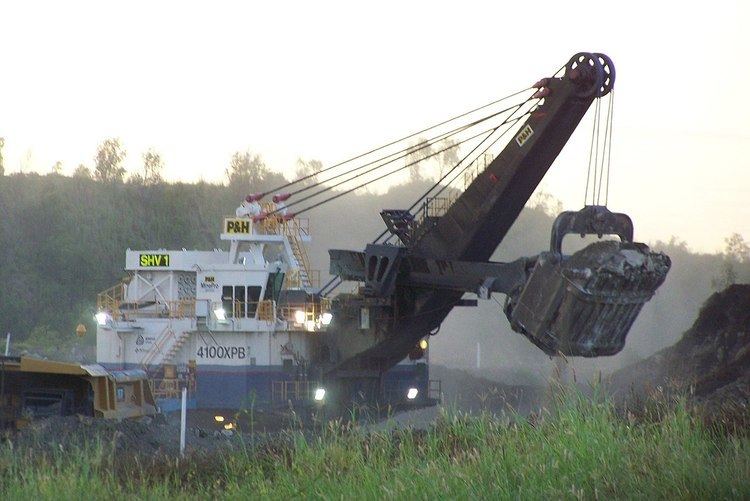 | ||
A power shovel (also stripping shovel or front shovel or electric mining shovel) is a bucket-equipped machine, usually electrically powered, used for digging and loading earth or fragmented rock and for mineral extraction.
Contents
Design
Shovels normally consist of a revolving deck with a power plant, driving and controlling mechanisms, usually a counterweight, and a front attachment, such as a crane ("boom") which supports a handle ("dipper" or "dipper stick") with a digger ("bucket") at the end. "Dipper" is also sometimes used to refer to the handle and digger combined. The machinery is mounted on a base platform with tracks or wheels. Modern bucket capacities range from 8 m3 to nearly 80 m3.
Use
Power shovels are used principally for excavation and removal of overburden in open-cut mining operations, though it may include loading of minerals, such as coal. They are the modern equivalent of steam shovels, and operate in a similar fashion.
Operation
The shovel operates using several main motions:
A shovel's work cycle, or digging cycle, consists of four phases:
The digging phase consists of crowding the dipper into the bank, hoisting the dipper to fill it, then retracting the full dipper from the bank. The swinging phase occurs once the dipper is clear of the bank both vertically and horizontally. The operator controls the dipper through a planned swing path and dump height until it is suitably positioned over the haul unit (e.g. truck). Dumping involves opening the dipper door to dump the load, while maintaining the correct dump height. Returning is when the dipper swings back to the bank, and involves lowering the dipper into the tuck position to close the dipper door.
Giant Stripping Shovels
In the 1950s with the demand for coal at a peak high and more coal companies turning to the cheaper method of strip mining, excavator manufacturers started offering a new super class of power shovels, commonly called giant stripping shovels. Most were built between the 1950s and the 1970s. The world's first giant stripping shovel for the coal fields was the Marion 5760. Unofficially known to its crew and eastern Ohio residences alike as The Mountaineer, it was erected in 1955/56 near Cadiz, Ohio off of Interstate I-70. Larger models followed the successful 5760, culminating in the mid 60s with the gigantic 15,000 ton Marion 6360, nicknamed The Captain.
